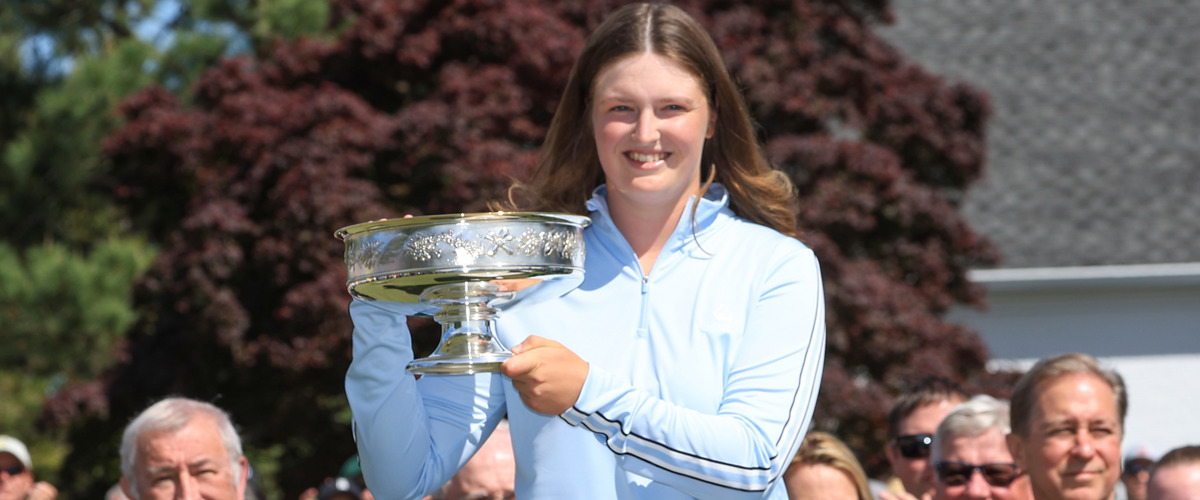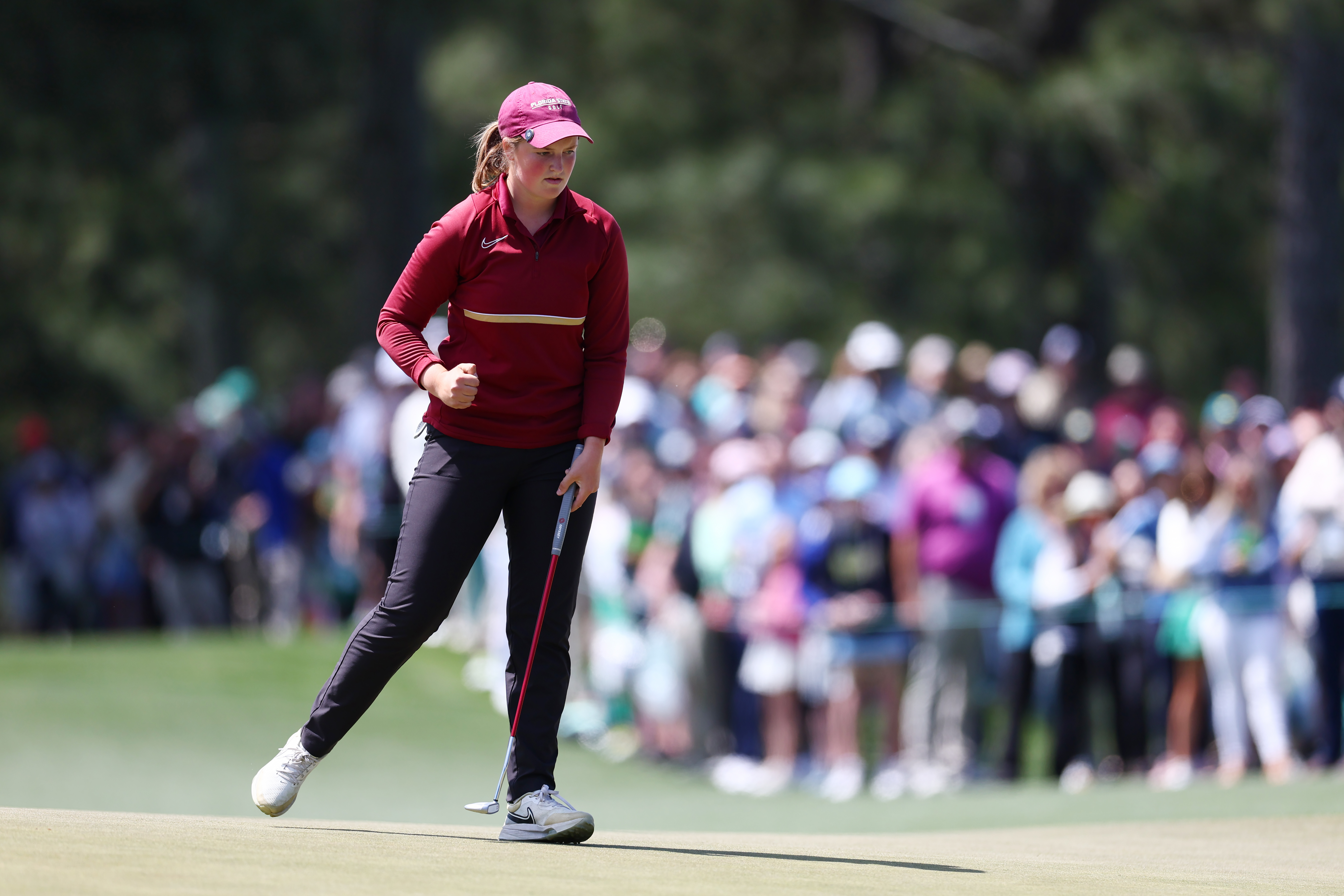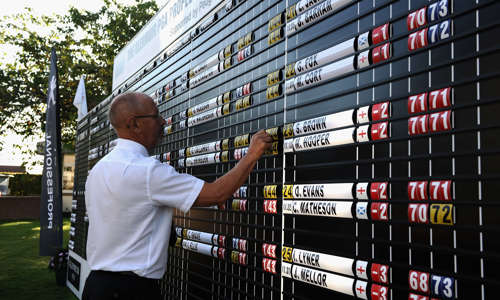Farnham Golf Club PGA Professional Luke Bone has enjoyed a whirlwind time in the spotlight as one of his star pupils, the amateur Lottie Woad, has performed at a world-class level on the women’s stage.
Firstly, accompanying her as her swing coach to Augusta National as she birdied the last three holes to win the Augusta National Women's Amateur (ANWA), then onto the Chevron Championship, where she proved her calibre in her Major debut, finishing in an impressive tie for 23rd position, alongside England compatriots Charley Hull and Georgia Hall.
In our exclusive interview Luke Bone reveals the secrets of their success…
Q. Tell us a little about the incredible journey you’ve been on together over the last few weeks.
A. Lottie’s success has come out of the blue for a lot of people who were unaware of who she was. She’s a very impressive young lady. Even the members of Farnham Golf Club, who knew of Lottie’s amateur record, were excited to see her on TV. She’s the talk of the town. Everyone has been betting on her. There’s a whole buzz about the place. In terms of my career, it’s easily the best week I have ever had.
Q. What impressed you most about Lottie’s performance in winning the Augusta National Women’s Amateur?
A. From watching her live, I’d say it was just her total belief in herself. She genuinely believes that this is where she’s supposed to be and this is what she can do. She’s such a hard worker. she’s hit so many golf balls compared to other people. She’s out-working them all. That has led to a full belief that she can do it. So her determination, hard-work and discipline has resulted in belief. Everything she has said she is going to do so far she has done it. So whatever she wants to achieve going forward, I’m not one to bet against it.
What specific work did you do in preparation for the ANWA?
A. On the first day, after the practice round, we spent about two hours on the range. Not doing anything dramatically different but just making sure that she was comfortable. Nothing too technical but just ensuring that she could hit the stock shot that she wanted, which is a tight little draw. Her pattern of movement, if anything, is too neutral. What I mean by that, is she starts hitting it straight when she’s intending to play a draw. So for me it was all about getting her comfortable and in control. That’s almost always what our patterns of movement are based around. How we do that is just working on the best thing that resonates with her each and every time.
Q. Lottie came through the Junior Academy that you led at Farnham Golf Club from the age of seven. Was learning skills, like shot-shaping, a big part of what you coached back in those early days?
A. When I first started coaching Lottie I was very much straight out of the PGA training. So it was all based around getting the fundamentals right, working on grip, posture, takeaway. The interesting thing is that if I had that time back again and was coaching those 7-10 year-olds I would do it in a fundamentally different way. Now it would be more about exploration and skill development and task orientation from the very beginning. But part of being a coach is going on that journey of learning. When you come straight out of the PGA training you’ve done a limited amount of coaching and probably only in one way. Quite often you haven’t been exposed to anything different unless you go out and find it. Lottie sits either side of my journey in coaching, from a raw kid, with plenty of enthusiasm where she had a lot of fun in the academy alongside all the other kids, to now.
Q. Would you say she has a natural talent for golf?
A. I have a bit of an issue with the word talent. It’s over-used. Lottie certainly has a talent for hard work, determination, focus and now off the back of that belief in herself. I’ve coached over 200 juniors in my time and if you had all them in front of me right now at the age of 10 or 11, she wouldn’t be in the top 10, maybe not even in the top 20 in terms of golf swing. In fact, Alex Saary, who is the England Golf Girls south-west coach, said the same thing to me when he first met her. Based on just her technique you wouldn’t have put her in the squad. Yet, like me, he saw something in her - that determination even as a young girl. She had a very competitive nature, was very disciplined and hard-working. As a youngster she wasn’t a stand-out golfer. She was very individualistic in her technique, which you can still see in the remnants of her swing today. She got her handicap down to single figures and she shot level par at the age of 12 or 13 around Blackmoor Golf Course, which is close to us, and honestly on that day something switched in her. Like a lightbulb turning on. She did something which surprised her but that she also loved. From that day she was like, ‘this is what I’m going to do’.
Q. Lottie is studying at Florida State University. Explain how you manage to effectively coach her from afar?
A. Lottie and I speak regularly and have on-line sessions while she is at Florida State University. We do big bodies of work face-to-face together in the times when she is back home over the summer and at Christmas. Because we have been working together for so long, and work efficiently when we are together, I can develop a set of things for her to work on that are based around her patterns and the tendencies I know from over the years. Any drills that we are doing and working on she essentially just repeats them on-line and gives me as much feedback as best she can. It’s all about reinforcement. One of the members at the golf club described my role with her as almost “like a comfort blanket”. I basically talk to her while she hits balls. I question her on what is going on, make sure that she is giving me feedback. So we just reinforce the work we were doing.
Q. How would you describe Lottie’s swing technique?
A. If you watch her swing there is a very definite pattern to it, which some people might describe as an over-the-top move, but it really isn’t. She doesn’t come over-the-top in a swing path sense but she moves from deep to a good position in the backswing to the downswing, which gets her in a fantastic slot in the downswing every time. It just so happens that the backswing is deeper than the downswing, which I think some of the best ever have done. Jack Nicklaus in his prime hitting a fade. Tiger in 2000. Brooks Koepka these days. There’s some very, very consistent golfers who make a similar move. What she has managed to do through hard work, is become very aware of what she is trying to do with her ball flight and the club. She has developed, within her own patterns, the ability to hit any shot. It’s one of the main strengths she has got, compared to some of the other players that I’ve seen at the top level. She understands her pattern and she can hit any golf shot shape-wise. That’s what separates her.
Q. So in your opinion, is coaching players the art of shot-making critical?
A. One of my big things is being able to move the ball in different ways in practice intentionally. You might not always need to use all those shots on the course but I think that demonstration of skill and awareness of how to hit those shots is important. Understanding what you are trying to do with the ball and the requirements of that situation. It’s very easy to get lost in position and technique, P1, P2 and so on. I don’t play golf like that myself. In fact I don’t know anyone who can play golf like that. You have to be task-orientated rather than technique orientated. You can merge the two at Lottie’s level. I get her to understand the position but in the heat of battle she’s just trying to hit a certain golf shot. I’m not a majorly technical or positional coach. I work backwards from the ball flight focusing on the player understanding what I am trying to get them to do at impact and then build a technique off that. In other words, making the technique organic to the things that the player is trying to do with the ball and the club.
It should be a prerequisite at every golf club that there is some sort of junior academy because it’s the future of the club, it’s the future of your golf coaches at that club and it’s the future of golf.
-
Q. It’s been quite a journey for you with Lottie then from her formative days in golf as a junior now to the best female amateur in the world. How has that helped you develop as a coach?
A. I’ve learned a lot from seeing what she’s done firstly in the Surrey coaching set-up, then onto the south region training and now as part of the England Golf set-up at a national level. Most of all it made me realise that there’s making a good golf swing or a person who can hit the ball and then there’s making one who understands process and how you practise, learning discipline in what you are doing. Add to that things like tournament preparation. All of these things that have been added into her arsenal over the years.
Q. Lottie has quite a coaching team, everyone from the England coaching set-up through to her university coaches. How do you manage that situation of her working with multiple influences?
A. I’ve always been very open. I’m not a possessive coach at all. I think the best interests need to lie with the person you are coaching. I think that Lottie knows what is good for her. I’ve got her best interests in mind and I’ve known her since she was seven. So we’ve been through an awful lot together, all through those teenage years, junior development, disappointments and all sorts of stuff. I’ve gained her trust. I think she would class me as her swing coach. She has England’s Steve Robinson as her performance and short game coach. He’s fantastic. All the time we spent together at Augusta National, watching him work with her, I was learning. Being around great coaches is amazing, picking their brains and developing your own style around that. In terms of the performance side of things, because I coach mainly at a golf club where the handicaps are mid-to-high, I’m not surrounded by elite amateurs like Lottie day-in, day-out. Most of what I do with players is simply skill acquisition - improve their driving, improve their pitching, improve their chipping. The next element of that is performance coaching, which I’m beginning to do more of with some juniors who I have coming through the ranks. Testing performance and challenging performance rather than just developing skill.
Q. Who else is part of Lottie’s coaching team?
A. Lottie has Nick Soto as her putting coach. He was over at the Chevron Championship with her. He’s Charley Hull’s putting coach as well and is also part of the England Golf set-up. Out in Florida State she has coach Amy Bond who is her team manager alongside Robert Duck. They are both there more on the management and performance side of things. Lottie and I speak every week and I speak to her coaches at least once every semester. I want to know from their eyes on the ground what they see and obviously it’s just marginal gains with Lottie because of where she is at already. Also the character insights I can give to them often just confirm what they are observing anyway. The communication is key.
Q. So it would be fair to say that your role is to help Lottie filter all the information from many coaching sources and help keep it straight-forward and understandable for her?
A. In a way yes. Even going back to her early days in the England south region coaching set-up working with Alex Saary on 3D swing work, trying to get her swing speed up. I was often having conference meetings with them on what they had done. I almost acted as that lightning rod for Lottie, especially back when she was younger, because it’s quite a lot to understand. I had to give her the swing sensation that was going to help her make the change.
Q. Which other coaches have you been influenced by?
A. I’d say Kendall McWade and Steven Orr. They have made me consider my own game and more importantly how I coach other people. Using constraints, tasks and language to get people to consider the problem properly. I really do feel that often as coaches we are making the game too complicated. Clarity is key. Often I feel that coaching directs the player’s attention away to secondary not primary factors. My big philosophy is the ball does what it is told. It doesn’t know you’ve got a left arm, never mind whether it is straight or not! Of course, bending your left arm is not necessarily conducive to hitting that ball consistently, but I think we have to understand the tools we are using before we start worrying about the technique. When I think about how I was trained as a golfer and then coached in that same way and found barriers and restriction for my own game, it put fear and doubt in my game. And yet I was simply regurgitating that method back to my clients in those early days. It’s a slightly different approach that I now take. I call it reverse engineering. The problem in this game is trying to advance the ball. The solution comes between how you hit the ball and how we build a technique that does that once you understand what the club and the ball have got to do. Golf is, after all, just a hitting skill.
Q. How big a role do parents play in child development and how do you involve them in the process?
A. Having the parents on board is essential to the learning journey. Lottie’s parents are incredibly supportive. Her Dad is a good single figure golfer and a massive sports fan. His dedication to running her around the country with her whilst holding down a full time job himself deserves incredible credit. He’s now retired and able to enjoy her success. He’s got an encyclopaedic knowledge of her golf. By the time I’d walked the practice round at the ANWA with Lottie, I knew every single shot that she’d hit the year before on both rounds from him.
Kendall McWade and Steven Orr have made me consider my own game and more importantly how I coach other people.
-
Q. How big a role do parents play in child development and how do you involve them in the process?
A. Having the parents on board is essential to the learning journey. Lottie’s parents are incredibly supportive. Her Dad is a good single figure golfer and a massive sports fan. His dedication to running her around the country with her whilst holding down a full time job himself deserves incredible credit. He’s now retired and able to enjoy her success. He’s got an encyclopaedic knowledge of her golf. By the time I’d walked the practice round at the ANWA with Lottie, I knew every single shot that she’d hit the year before on both rounds from him.
Q. What advice can you give to fellow PGA Members who are in their formative years as a coach, about nurturing and developing talent?
A. There’s a few things. Firstly, you must go and find information that disrupts what you currently believe. You must learn more. I’ve done it a lot over the years. I don’t regret anything in life but I would have liked to have started my development as a coach earlier by disrupting it earlier. Go and spend time with other good coaches, find PGA seminars to attend, go to things that maybe doesn’t even agree with what you think. Challenge yourself in that way. That is where you will find your own voice. Then on top of that I would say exploring how to achieve tasks. Give pupils problems to solve not positions to hit. Do not restrict them by telling them where to put their feet, where to put their hands, for as long as you can. Because I think if you get good at coaching in this way you can get people to choose the correction positions and the correct grips. From what I’ve seen, as I’ve developed this method of coaching, is that people can adopt the correct things if you give them real clarity, rather than tell them in the first few hours when you meet them where to put their hands on the club. That leads to my third and final point, learning golf has to be fun. It should be a prerequisite at every golf club that there is some sort of junior academy because it’s the future of the club, it’s the future of your golf coaches at that club and it’s the future of golf.





































